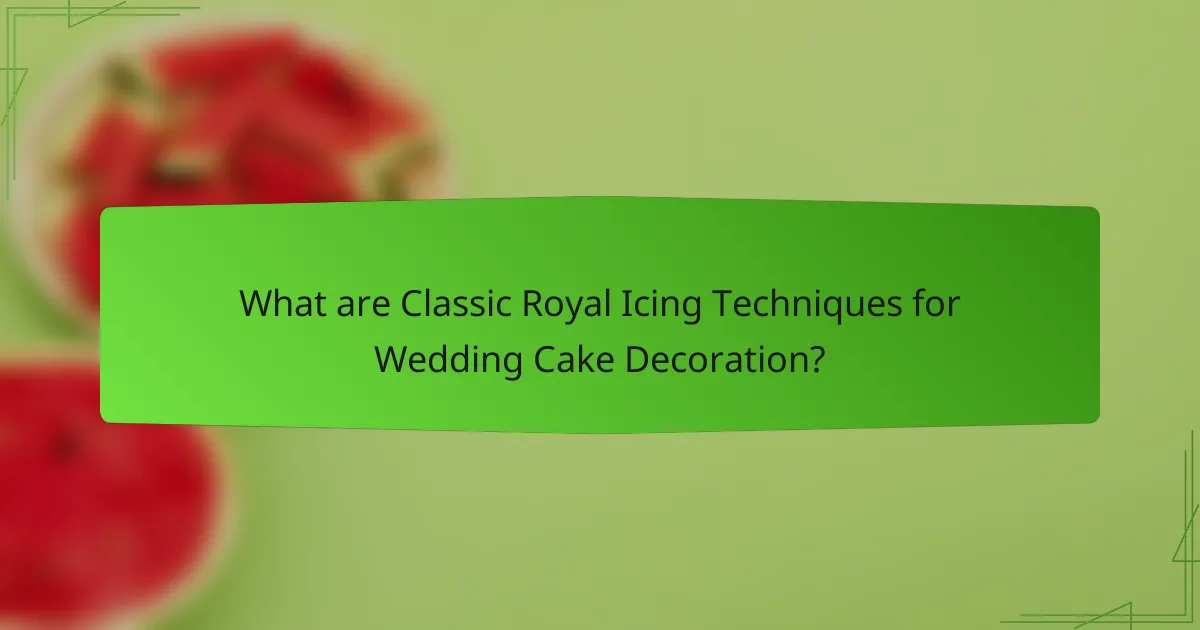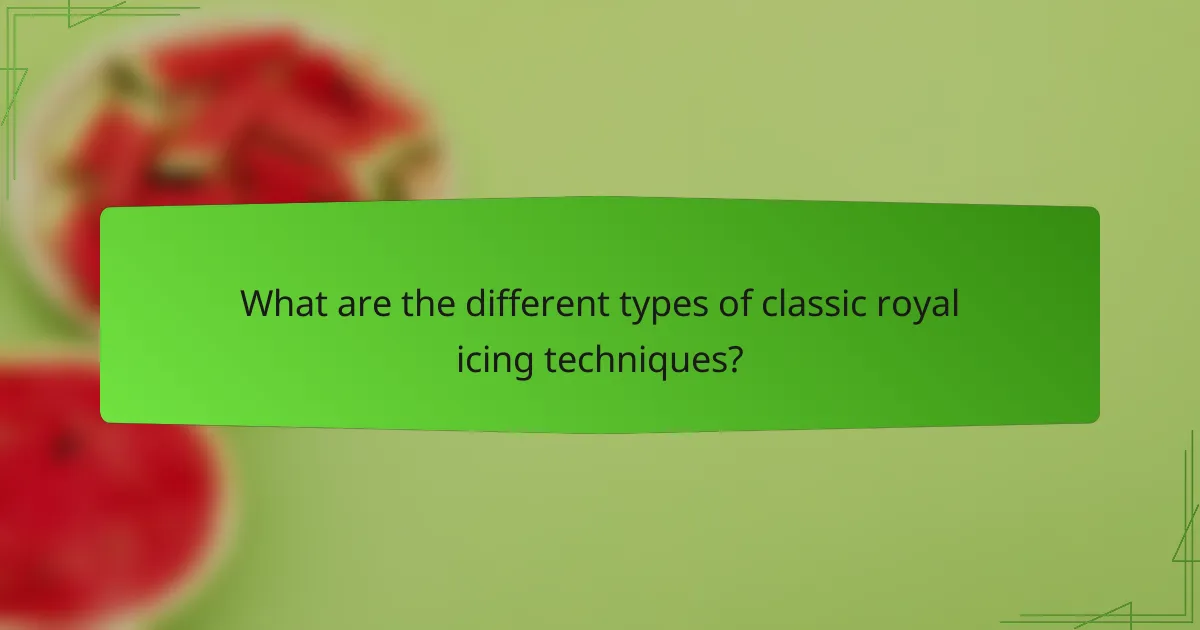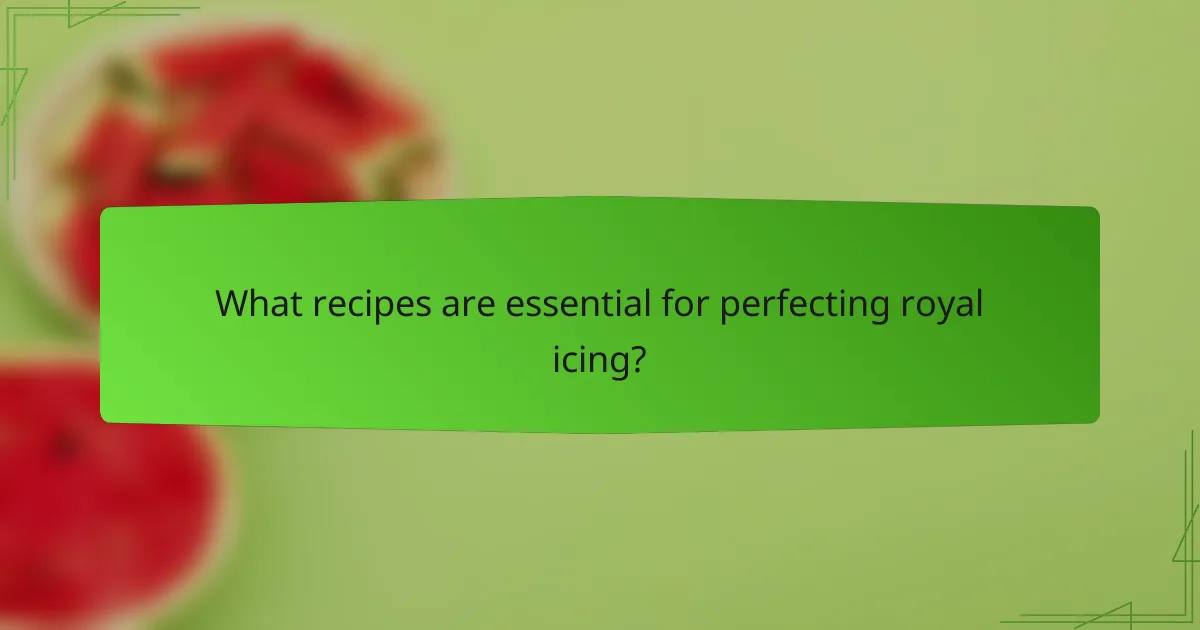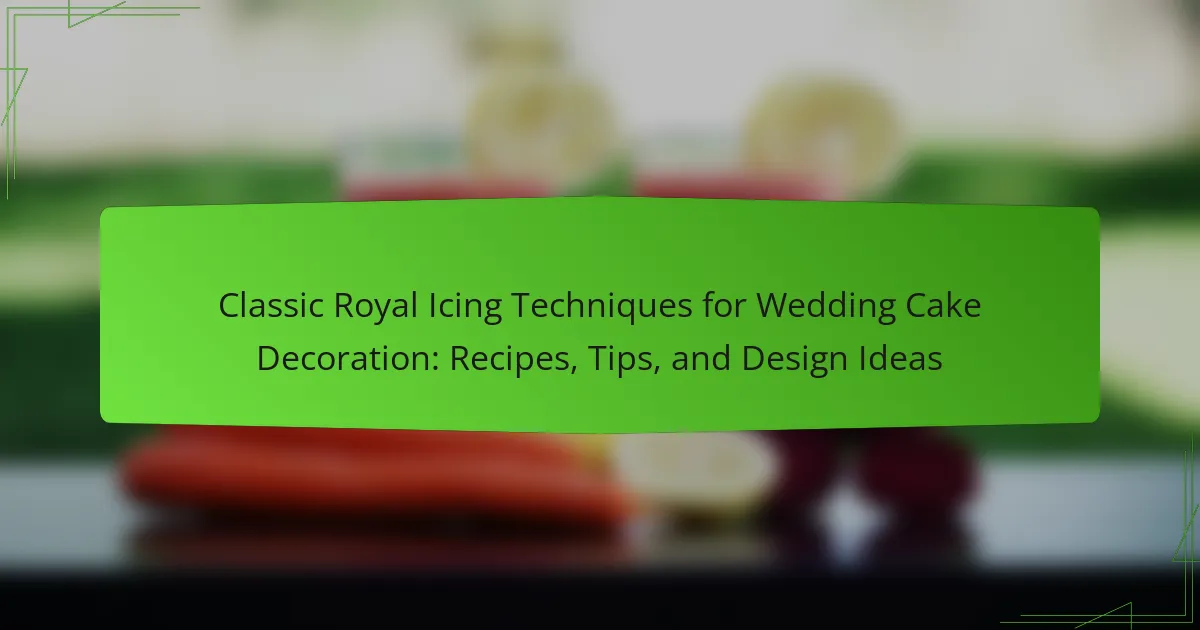
What are Classic Royal Icing Techniques for Wedding Cake Decoration?
Classic royal icing techniques for wedding cake decoration include piping, flooding, and stenciling. Piping involves using a piping bag to create intricate designs and borders on the cake. Flooding is the technique of filling in areas with a thinner consistency of royal icing for a smooth finish. Stenciling allows decorators to apply patterns using a stencil and royal icing, creating detailed designs. These techniques have been used historically in cake decoration, particularly in royal and formal settings. They provide a versatile way to achieve elegant and personalized designs on wedding cakes.
How is royal icing made for cake decoration?
Royal icing is made by combining egg whites, powdered sugar, and lemon juice or water. First, sift the powdered sugar to remove lumps. Then, in a mixing bowl, beat the egg whites until frothy. Gradually add the sifted sugar while mixing on low speed. Continue mixing until the icing reaches a stiff peak consistency. If desired, add lemon juice or water to adjust the texture. This icing dries hard, making it ideal for cake decoration. The use of egg whites provides stability and a glossy finish.
What ingredients are essential for making royal icing?
The essential ingredients for making royal icing are egg whites, powdered sugar, and lemon juice or vinegar. Egg whites provide structure and stability to the icing. Powdered sugar is the primary sweetener and thickener. Lemon juice or vinegar adds acidity, which helps to stabilize the icing. These ingredients combine to create a smooth, glossy icing suitable for decorating cakes and cookies. The use of egg whites is a traditional method, while meringue powder can be used as an alternative for safety.
What techniques are used to achieve the right consistency?
To achieve the right consistency for royal icing, several techniques are utilized. Mixing powdered sugar with egg whites or meringue powder creates the base. Gradually adding water helps to adjust the thickness. Using a stand mixer ensures thorough blending and aeration. Testing the icing’s consistency involves the “10-second rule,” where a ribbon of icing should dissolve in about 10 seconds. Adjusting the water content fine-tunes the texture for piping or flooding. Additionally, letting the icing rest allows air bubbles to escape, enhancing smoothness. These techniques ensure the icing is suitable for detailed decorations on wedding cakes.
Why are classic techniques important for wedding cake decoration?
Classic techniques are important for wedding cake decoration because they provide a foundation for skillful artistry. Mastering these techniques ensures precision and consistency in design. Classic methods, such as piping and fondant work, have been refined over generations. They allow decorators to create intricate designs that enhance the cake’s visual appeal. Historical significance also plays a role; these techniques connect modern decorators to traditional practices. Furthermore, classic techniques often use stable materials, ensuring the cake’s longevity during events. Their reliability contributes to the overall success of wedding cakes.
How do traditional techniques enhance cake aesthetics?
Traditional techniques enhance cake aesthetics by providing intricate designs and textures. Techniques such as piping, fondant work, and sugar flowers create visually appealing elements. Royal icing, a common method, allows for fine detail and delicate patterns. These techniques have been used for centuries, adding elegance to cakes. Historical records show that royal icing was popularized in the 16th century. This method dries hard, ensuring designs maintain their shape. Traditional techniques also enable customization for various occasions, enhancing personal touches. Overall, they elevate the visual impact of cakes significantly.
What role do classic techniques play in cake longevity?
Classic techniques enhance cake longevity by promoting moisture retention and structural stability. Techniques such as proper mixing, baking at the right temperature, and using specific ingredients contribute to a cake’s overall durability. For instance, incorporating fat in the batter helps to create a tender crumb, which can retain moisture over time. Additionally, using royal icing as a decorative layer provides a protective barrier against air exposure. This barrier slows down staleness and helps maintain freshness. Historical baking practices have shown that these techniques can extend the shelf life of cakes significantly. Cakes made with these methods can remain edible for several days to weeks, depending on storage conditions.

What are the different types of classic royal icing techniques?
The different types of classic royal icing techniques include flooding, piping, and stenciling. Flooding involves filling in areas of a surface with thinned royal icing. This technique creates a smooth, glossy finish. Piping is used to create detailed designs and borders with thicker icing. It allows for intricate patterns and textures. Stenciling involves applying royal icing over a stencil to create specific shapes or designs. Each technique offers unique aesthetic possibilities for cake decoration. These methods are commonly used in professional cake decorating. They enhance the visual appeal of wedding cakes significantly.
How can piping techniques be applied in wedding cake decoration?
Piping techniques can be applied in wedding cake decoration to create intricate designs and textures. These techniques involve using a piping bag fitted with various nozzles. Common applications include borders, flowers, and lace patterns. Royal icing is often used for its smooth finish and ability to hold shape. For example, a star tip can create beautiful rosettes on the cake’s surface. Additionally, fine tips allow for detailed writing or delicate designs. Piping can also be used to add dimension, such as creating raised elements. Mastering these techniques enhances the visual appeal of wedding cakes significantly.
What are the best practices for piping royal icing designs?
The best practices for piping royal icing designs include using the right consistency of icing. A stiff consistency is ideal for outlining, while a thinner consistency is suitable for flooding. Use a piping bag fitted with a fine round tip for detailed designs. Practice control and pressure on the piping bag to achieve smooth lines. Allow each layer to dry before adding more details to prevent smudging. Keep the royal icing covered when not in use to prevent it from hardening. Use a toothpick to correct mistakes immediately after piping. These practices ensure clean, professional-looking designs.
What common piping mistakes should be avoided?
Common piping mistakes to avoid include using the wrong consistency of icing. Icing that is too thick can lead to uneven lines. Conversely, icing that is too thin may cause it to run or lose shape. Another mistake is applying too much pressure on the piping bag. This can result in excessive icing being released, creating messy designs. Additionally, not practicing enough can lead to a lack of control. Insufficient practice often results in wobbly lines and uneven patterns. Lastly, neglecting to clean the piping tip can cause blockages. Blockages can disrupt the flow of icing and ruin the design.
What are the painting and flooding techniques in royal icing decoration?
Painting techniques in royal icing decoration involve applying color directly onto dried icing surfaces. Common methods include using edible food colors and brushes. Flooding techniques involve applying a thin layer of royal icing to fill in shapes. This technique creates a smooth, even surface on cookies or cakes. Both techniques require a well-prepared royal icing consistency. For painting, the icing should be fully dried to prevent smudging. For flooding, the icing should be of a thinner consistency to flow easily. These techniques are essential for achieving intricate designs and vibrant colors in royal icing decoration.
How do flooding techniques create smooth surfaces?
Flooding techniques create smooth surfaces by applying a thin layer of royal icing over a base layer. This technique allows the icing to flow and fill in any gaps or imperfections. The consistency of the icing is crucial; it should be fluid enough to spread evenly but thick enough to hold its shape. As the icing dries, it levels out, resulting in a smooth finish. The use of a scribe tool can further assist in achieving a flawless surface by removing air bubbles. Additionally, proper drying conditions, such as low humidity, enhance the smoothness of the final product.
What tools are necessary for effective painting with royal icing?
Essential tools for effective painting with royal icing include piping bags, fine-tipped piping tips, and food-safe brushes. Piping bags allow for controlled application of royal icing. Fine-tipped piping tips enable precise detailing and line work. Food-safe brushes are necessary for blending and painting colors onto the icing surface. Additionally, a palette or mixing surface is useful for blending colors. A turntable aids in even application when decorating cakes. These tools collectively enhance the quality and precision of painted designs.

What recipes are essential for perfecting royal icing?
Essential recipes for perfecting royal icing include the classic meringue powder recipe and the egg white recipe. The classic meringue powder recipe combines 4 cups of powdered sugar, 3 tablespoons of meringue powder, and 5-6 tablespoons of water. This mixture creates a stable icing suitable for intricate designs. The egg white recipe uses 4 cups of powdered sugar and 2 large egg whites, whisked until stiff peaks form. This method yields a glossy finish ideal for piping. Both recipes are widely used by bakers for their reliability and ease of use in cake decoration.
How do different recipes affect the texture and taste of royal icing?
Different recipes significantly affect the texture and taste of royal icing. The ratio of powdered sugar to egg whites or meringue powder determines the icing’s consistency. A higher sugar content results in a thicker icing ideal for piping. Conversely, less sugar yields a runnier icing suitable for flooding. The type of liquid used, such as water or lemon juice, influences both flavor and drying time. Lemon juice adds a slight tang and can enhance the icing’s brightness. Additionally, incorporating flavor extracts can modify the taste profile, making it more appealing. Variations in mixing time and technique also contribute to air incorporation, affecting the final texture. Overall, the specific ingredients and their proportions dictate the performance of royal icing in decorating cakes.
What variations exist for royal icing recipes?
Variations for royal icing recipes include egg white-based, meringue powder-based, and vegan versions. Egg white-based royal icing uses raw egg whites as the primary ingredient. Meringue powder-based icing substitutes egg whites with meringue powder for a similar texture. Vegan royal icing replaces egg whites with aquafaba or other plant-based ingredients. Each variation adjusts the texture and stability of the icing. The egg white version offers a traditional taste. Meringue powder provides convenience and longer shelf life. Vegan options cater to dietary restrictions while maintaining functionality. These variations allow for flexibility in preparation and usage.
What is the significance of egg whites versus meringue powder in recipes?
Egg whites and meringue powder serve similar purposes in recipes, particularly in royal icing. Egg whites provide natural proteins and moisture, which help create a smooth, glossy finish in icing. They also contribute to the structural integrity of the icing, allowing it to hold its shape when piped.
Meringue powder, on the other hand, is a dehydrated form of egg whites. It offers convenience and longer shelf life. It can be reconstituted with water, making it easier to store and use in various recipes. Meringue powder also often contains stabilizers that enhance the icing’s durability.
Both ingredients produce similar results, but the choice depends on personal preference and specific recipe requirements. For instance, using egg whites may yield a richer flavor, while meringue powder simplifies the preparation process.
What tips can improve the application of royal icing on wedding cakes?
To improve the application of royal icing on wedding cakes, ensure the icing is at the right consistency. Aim for a smooth, flowable texture that holds its shape. Use a piping bag with a small round tip for detailed work. Practice steady pressure while piping to maintain even lines. Allow each layer of icing to dry before adding more details. This prevents smudging and maintains crisp edges. Use a toothpick to fix any mistakes or uneven areas. Finally, keep the workspace clean to avoid dust or debris in the icing.
How can temperature and humidity affect royal icing application?
Temperature and humidity significantly influence royal icing application. High humidity can cause royal icing to become too soft and sticky. This makes it difficult to achieve clean lines and defined shapes. Conversely, low humidity can lead to a quick drying time. This may result in cracking and uneven surfaces. Ideal conditions are a moderate temperature and humidity level. These conditions allow for smooth application and proper drying. For example, a temperature around 70°F and humidity around 50% are often recommended. This balance ensures the icing retains its structure while still being workable.
What are some common troubleshooting tips for royal icing decoration?
Common troubleshooting tips for royal icing decoration include ensuring the right consistency of the icing. A stiff peak is ideal for outlining, while a softer consistency is necessary for flooding. If the icing is too runny, add more powdered sugar. Conversely, if it is too thick, add a small amount of water.
Another tip is to avoid air bubbles, which can ruin the appearance. Gently tapping the decorated surface can help release trapped air. If the icing cracks, it may be too dry; cover it with a damp cloth to rehydrate.
For issues with color, ensure that gel food coloring is used, as it does not alter the icing’s consistency. Lastly, humidity can affect drying times; using a fan can help speed up the process in humid environments.
What design ideas can be explored with classic royal icing techniques?
Classic royal icing techniques can be used to create intricate designs on wedding cakes. Popular design ideas include lace patterns, which mimic the elegance of fabric. Another idea is floral decorations, where royal icing can form detailed flowers. Geometric shapes can also be crafted, adding a modern touch to traditional cakes. Additionally, monograms and personalized messages can be piped with precision. Using stencils allows for consistent patterns across multiple cakes. Finally, 3D elements can be fashioned, such as bows or figurines, enhancing the visual appeal. These techniques provide versatility and creativity in cake decoration.
How can floral designs be created using royal icing?
Floral designs can be created using royal icing by piping intricate flower shapes onto a surface. Start by preparing a stiff royal icing consistency for detailed work. Use a piping bag fitted with a round tip to outline the flower shapes. Fill in the outlines with a slightly thinner icing for smooth coverage. Layer different colors to create depth and dimension in the flowers. Allow each layer to dry before adding additional details, like petals or leaves. Common flowers include roses, daisies, and violets, which can be achieved with varying techniques. The versatility of royal icing allows for both simple and complex floral designs.
What are some unique patterns and textures achievable with royal icing?
Unique patterns and textures achievable with royal icing include lace, marbling, and stenciling. Lace patterns can be created by piping intricate designs, resembling delicate fabric. Marbling involves swirling different colors of icing together for a blended effect. Stenciling allows for precise shapes and designs by applying icing over a stencil. Other textures like ruffles and peaks can be formed by adjusting the piping technique. Each technique requires specific consistency and skill in application. These methods enhance the visual appeal of wedding cakes significantly.
Classic royal icing techniques are essential for wedding cake decoration, encompassing methods such as piping, flooding, and stenciling. This article provides a comprehensive overview of how to make royal icing, the key ingredients involved, and techniques for achieving the right consistency. It also highlights the importance of traditional methods in enhancing cake aesthetics and longevity, while offering practical tips for effective application. Additionally, various design ideas, including floral patterns and unique textures, are explored to inspire creativity in cake decorating.
